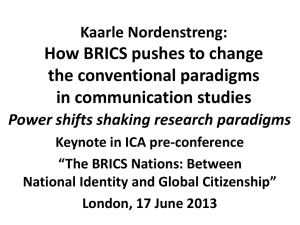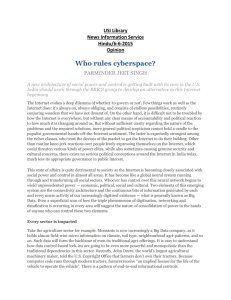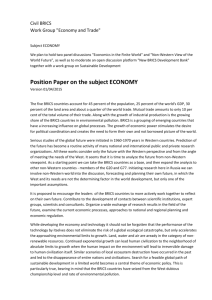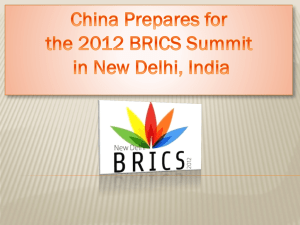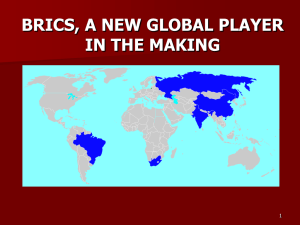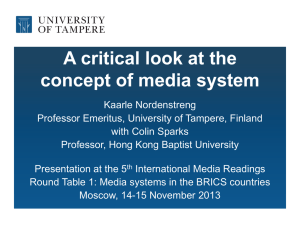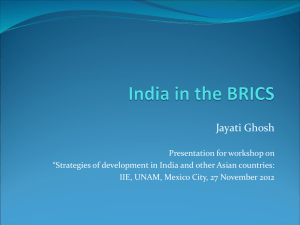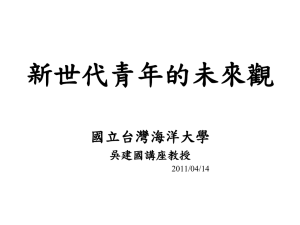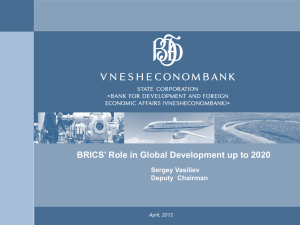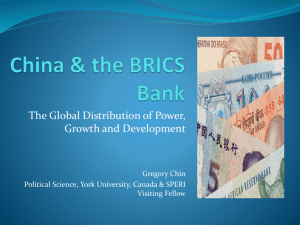View/Open - OpenDocs - Institute of Development Studies
advertisement
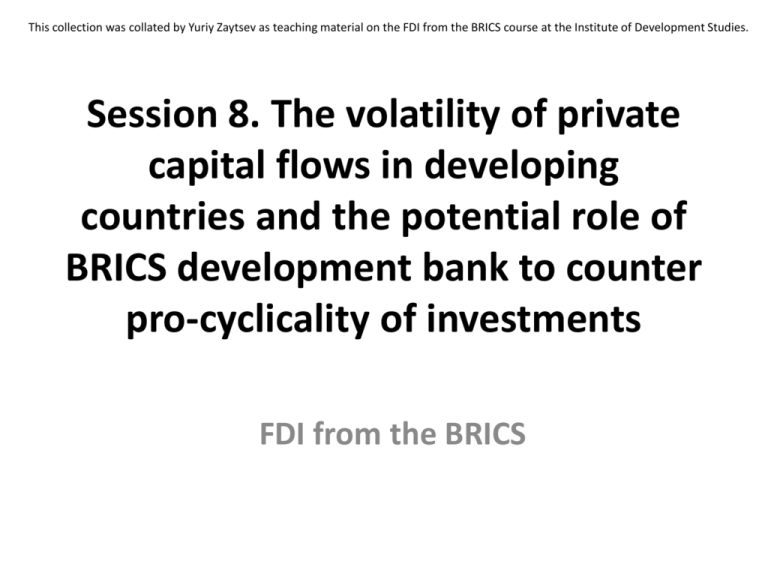
This collection was collated by Yuriy Zaytsev as teaching material on the FDI from the BRICS course at the Institute of Development Studies. Session 8. The volatility of private capital flows in developing countries and the potential role of BRICS development bank to counter pro-cyclicality of investments FDI from the BRICS Session Overview 1. The reasons of volatility of private capital flows in developing countries; 2. The role of mechanisms to counter the procyclical pattern that characterizes private capital flows; 3. The role of BRICS development bank in international development cooperation: – “South-South cooperation” framework, – Bank’s role in counter-cyclical prudential regulations. BRICS Development Bank: the emergence of idea • The incentive: – To create a development finance institution not dominated by developed countries – To meet the gap in lack of resources, – To address instability of the private capital flows in developing countries. • Will the BRICS Bank change “development” paradigm? – Directly - through the way it operates as a public, multilateral development bank. • Will be BRICS Bank different? – Indirectly - through its wider impacts on the development cooperation system. BRICS Bank functions • Lending to the sectors: – Commercial banks focus on the most profitable activities, but development is not always a question of profit; – Infrastructure and agriculture are other key sectors that commercial banks tend to neglect; – Some key sectors, such as SME’s, are not particularly profitable; – Lending small amounts to lots of small firms is far less appealing than lending large amounts to a few large firms. • Providing the right type of finance: – Infrastructure projects need long-term finance, but commercial banks are very bad at providing this; – Development banks can provide long-term financing; – Development banks may also lend at below market rates when high social returns are achievable, but financial returns are low. • Consider the broader public good when taking decisions: – Ensuring good wages are paid and human rights respected may not increase a project’s financial returns, but are important for the broader public good. BRICS Development Bank Indicators* • Sectors Indicators: – the focus will be infrastructure, where there is a huge funding gap. – The BRICS countries need USD4.5 trillion of investment over the next 5 years; – the infrastructure financing gap in Africa is USD50 billion per year. • Financing mechanisms indicators: – Public banks in some BRICS countries have shown a greater willingness to provide concessional loans than the World Bank and RDBs. – Brazil played an important counter-cyclical financing role in the 2007-8 crisis, and are the main sources of long-term finance. – Importantly, the BRICS bank is likely to be less ideologically fixated on providing finance at market rates than current institutions. • • • • • Non-financial aspects of lending indicators: What will local communities have in projects? What weight will be given to human rights and other social factors? Will potential projects’ real environmental impact be taken into account when taking decisions? How transparent will the Bank be in its operations? *Suggested by Stephen Spratt BRICS Development Bank: the way forward • Will the BRICS provide capital in line with their economic weight, or equal amounts? • Will voting rights reflect these different contributions, or other considerations? • Will non-BRIC countries have in the Bank’s activities? • How will be the Bank be financed beyond its initial capitalization? • How broad or narrow will the bank’s mandate be in terms of countries, sectors, and potential financing instruments, including concessional finance? • What role will non-financial factors play in its lending decisions? • How will its performance be assessed? NB: The World Bank will have a serious competitor for the first time. The volatility of private capital flows in developing countries and the potential role of BRICS development bank to counter pro-cyclicality of investments • At the current stage several options are available for developing countries to counter the pro-cyclical pattern that characterizes private capital flows. – designing mechanisms to encourage more stable private flows (countercyclical guarantees) or that distributing better the risk faced developing countries throughout the business cycle; – introducing prudential capital accounts regulations and adopting countercyclical prudential regulations for the domestic financial system. • Not all of the above mentioned mechanisms are effectively used in developing countries. • Moreover, many of them do not have such institutions, which could support the development and effective use of these mechanisms (e.g., in the development of domestic bonds market), as well as to exercise prudential regulations on the capital account and counter-cyclical prudential regulations. • BRICS development bank as a new MDB could meet this gap. Why does macroeconomic volatility appear to be especially harmful for the poor? • Poor have the least access to financial markets: – difficulty in making diversification the risks associated with their income, which is often based on a narrow set of sources; • Direct affect by changes in government spending: – Health and education; – Procyclical fiscal policy. Financial integration • Benefits for developing countries: – Simultaneous to improve governance, transparency, and financial-sector regulation; – Moving to more flexible exchange rate regimes alleviate the risks; • Excessive reliance on fixed exchange rate regimes has been a major contributory factor to financial crises in emergingmarket countries over the past fifteen years; – Countries that consistently face problems associated with government debt are more likely to benefit from financial globalization if their governments simultaneously take measures to avoid an excessive buildup of debt.
